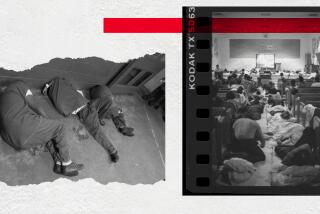Researchers figure out how to calm inmates in solitary confinement: Nature videos
- Share via
Reporting from Portland, Ore. — A study has found a novel way to reduce violence by prisoners in solitary confinement: Show them nature videos.
Prisoners who viewed ocean waves, waterfalls, aquariums and other serene images were 26% less likely to be disciplined for violence than a control group that did not watch the videos, according to research led by a forest ecologist and published Friday in the journal Frontiers in Ecology and the Environment.
The concept originated with Nalini Nadkarni, a professor at the University of Utah and an expert on the rain forest canopies of Costa Rica, and was premised on research that people with regular exposure to nature, or even images of nature, were calmer.
In 2013, Oregon officials invited her to bring the idea to the state’s biggest prison, the Snake River Correctional Institution. The viewing space — and the project itself — became known as the Blue Room, for the glow of the videos.
After Time Magazine named it one of the top 25 inventions of 2014, select maximum-security units in Washington, Florida and Alaska set up their own Blue Rooms.
But for all the promise the concept showed, the Blue Room idea had not been scientifically tested — until now.
Researchers spent a year studying inmates in a cellblock of the Snake River facility’s Intensive Management Unit, where prisoners are sent when they harm guards or other inmates.
The prisoners are kept behind steel doors for 23 hours and 20 minutes a day, under fluorescent light with no windows to the outside world.
Inmates in 24 cells were allowed to spend 40 minutes a day alone in a small room equipped with a pull-up bar and a projector that showed the nature videos. Inmates in 24 other cells on the other side of the cellblock were given the same access to an identical room, but without the videos.
Nadkarni worried that prisoners allowed to watch the videos might react negatively to images of the natural world that had been denied to them.
“We found that it was the opposite, and they were soothed by it,” Nadkarni said. “They reacted by feeling calm, less stressed out. The bottom line is that it actually resulted in behavioral changes.”
Surveys of the inmates showed that deserts and other barren landscapes often were more popular than waves, reefs or the perfect sunset. The wide-open spaces gave the prisoners relief from their closed-in environs, providing them a greater sense of openness and freedom.
One inmate, heavily tattooed and with a shaved head, told Nadkarni about the joy of watching videos of the ocean, choking up as he described boyhood trips to the beach with his family and dreams of one day taking his own child to the shore.
Leon Digard, a senior researcher at the nonprofit Vera Institute of Justice who was not involved in the experiment but is familiar with it, said it had “obvious value” for people in solitary confinement.
But he said it would be preferable for corrections officials to provide the nature videos to inmates in the general inmate population, which might keep them out of solitary in the first place.
The Oregon Department of Corrections is the only prison system that has done that — but only for women. The Coffee Creek Correctional Facility, the state’s only prison for women, recently provided the Nature Imagery Channel to prisoners with access to TV.
They can watch the channel around the clock, and some use it as a meditation tool, said Chad Naugle, who manages the prison system’s environmental sustainability program.
“Besides reducing stress and agitation,” he said, “I think it gives them an option to escape from prison life and the drama in their units.”
Dan Mears, a Florida State University criminology professor and an expert in solitary confinement, said that offering Blue Room privileges to inmates probably does calm them. He recalled growing calm, and distracted, while watching fish videos in his dentist’s chair.
But he said that giving inmates any kind of free choice — reading a book, sitting in a weight room with music, even standing outside the door to their cell for a few minutes — probably would do the same thing.
“These are inmates who have almost no options,” Mears said. “So when you’re confronted with an opportunity to exercise an option, that can be calming.”
Nadkarni and her research team hope to expand the Blue Room concept to other people deprived of contact with nature.
Those could include toll-booth operators, big-city residents without nearby parks, occupants of military barracks, workers who toil in cubicles and factories without windows nearby, and even astronauts, Nadkarni said.
“It’s not just prisoners who are deprived of nature in American society,” Nadkarni said. “Many ecologists and behavioral psychologists are concerned about negative impacts of this loss of connection with real nature, or even nature imagery. What I think this project has taught us is that nearly everybody can benefit.”
Denson is a special correspondent.
More to Read
Sign up for Essential California
The most important California stories and recommendations in your inbox every morning.
You may occasionally receive promotional content from the Los Angeles Times.













